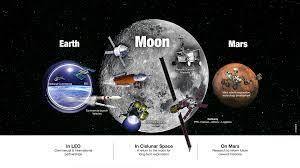Courtesy : /en.wikipedia.org
Moon exploration
The physical exploration of the Moon began when Luna 2, a space probe launched by the Soviet Union, made an impact on the surface of the Moon on September 14, 1959. Prior to that the only available means of exploration had been observation from Earth. The invention of the optical telescope brought about the first leap in the quality of lunar observations. Galileo Galilei is generally credited as the first person to use a telescope for astronomical purposes; having made his own telescope in 1609, the mountains and craters on the lunar surface were among his first observations using it.
NASA’s Apollo program was the only program to successfully land humans on the Moon, which it did six times. The first landing took place in 1969, when two Apollo 11 astronauts placed scientific instruments and returned lunar samples to Earth.
The first unmanned landing on the far side of the Moon was made by the Chinese spacecraft Chang’e 4 in early 2019, which successfully deployed the Yutu-2 lunar rover.
Before spaceflig
See also: Selenography and Lunar theory
The ancient Greek philosopher Anaxagoras (d. 428 BC) reasoned that the Sun and Moon were both giant spherical rocks, and that the latter reflected the light of the former. His non-religious view of the heavens was one cause for his imprisonment and eventual exile. In his book On the Face in the Moon’s Orb, Plutarch suggested that the Moon had deep recesses in which the light of the Sun did not reach and that the spots are nothing but the shadows of rivers or deep chasms. He also entertained the possibility that the Moon was inhabited. Aristarchus went a step further and computed the distance from Earth, together with its size, obtaining a value of 20 times the Earth radius for the distance (the real value is 60; the Earth radius was roughly known since Eratosthenes).
Although the Chinese of the Han Dynasty (202 BC–202 AD) believed the Moon to be energy equated to qi, their ‘radiating influence’ theory recognized that the light of the Moon was merely a reflection of the Sun (mentioned by Anaxagoras above).This was supported by mainstream thinkers such as Jing Fang, who noted the sphericity of the MoonShen Kuo (1031–1095) of the Song Dynasty (960–1279) created an allegory equating the waxing and waning of the Moon to a round ball of reflective silver that, when doused with white powder and viewed from the side, would appear to be a crescent.
By 499 AD, the Indian astronomer Aryabhata mentioned in his Aryabhatiya that reflected sunlight is what causes the Moon to shine.
Habash al-Hasib al-Marwazi, a Persian astronomer, conducted various observations at the Al-Shammisiyyah observatory in Baghdad between 825 and 835 AD. Using these observations, he estimated the Moon’s diameter as 3,037 km (equivaent to 1,519 km radius) and its distance from the Earth as 346,345 km (215,209 mi). In the 11th century, the Islamic physicist Alhazen investigated moonlight through a number of experiments and observations, concluding it was a combination of the moon’s own light and the moon’s ability to absorb and emit sunlight.
By the Middle Ages, before the invention of the telescope, an increasing number of people began to recognise the Moon as a sphere, though many believed that it was “perfectly smooth”. In 1609, Galileo Galilei drew one of the first telescopic drawings of the Moon in his book Sidereus Nuncius and noted that it was not smooth but had mountains and craters. Later in the 17th century, Giovanni Battista Riccioli and Francesco Maria Grimaldi drew a map of the Moon and gave many craters the names they still have today. On maps, the dark parts of the Moon’s surface were called maria (singular mare) or seas, and the light parts were called terrae or continents.
Galileo‘s sketches of the Moon from the groundbreaking Sidereus Nuncius
Thomas Harriot, as well as Galilei, drew the first telescopic representation of the Moon and observed it for several years. His drawings, however, remained unpublished.The first map of the Moon was made by the Belgian cosmographer and astronomer Michael Florent van Langren in 1645.Two years later a much more influential effort was published by Johannes Hevelius. In 1647 Hevelius published Selenographia, the first treatise entirely devoted to the Moon. Hevelius’s nomenclature, although used in Protestant countries until the eighteenth century, was replaced by the system published in 1651 by the Jesuit astronomer Giovanni Battista Riccioli, who gave the large naked-eye spots the names of seas and the telescopic spots (now called craters) the name of philosophers and astronomers.
A study of the Moon from Robert Hooke’s Micrographia, 1665
In 1753 the Croatian Jesuit and astronomer Roger Joseph Boscovich discovered the absence of atmosphere on the Moon. In 1824 Franz von Gruithuisen explained the formation of craters as a result of meteorite strikes.
The possibility that the Moon contains vegetation and is inhabited by selenites was seriously considered by major astronomers even into the first decades of the 19th century. In 1834–1836, Wilhelm Beer and Johann Heinrich Mädler published their four-volume Mappa Selenographica and the book Der Mond in 1837, which firmly established the conclusion that the Moon has no bodies of water nor any appreciable atmosphere.
The earliest surviving daguerrotype of the Moon by John W. Draper (1840)
Photo of the Moon made by Lewis Rutherfurd in 1865
Space race
Main articles: Space Race and Moon landing
See also: Apollo program and Soviet crewed lunar programs
The Cold War-inspired “space race” and “Moon race” between the Soviet Union and the United States of America accelerated with a focus on the Moon. This included many scientifically important firsts, such as the first photographs of the then-unseen far side of the Moon in 1959 by the Soviet Union, and culminated with the landing of the first humans on the Moon in 1969, widely seen around the world as one of the pivotal events of the 20th century, and indeed of human history in general.




